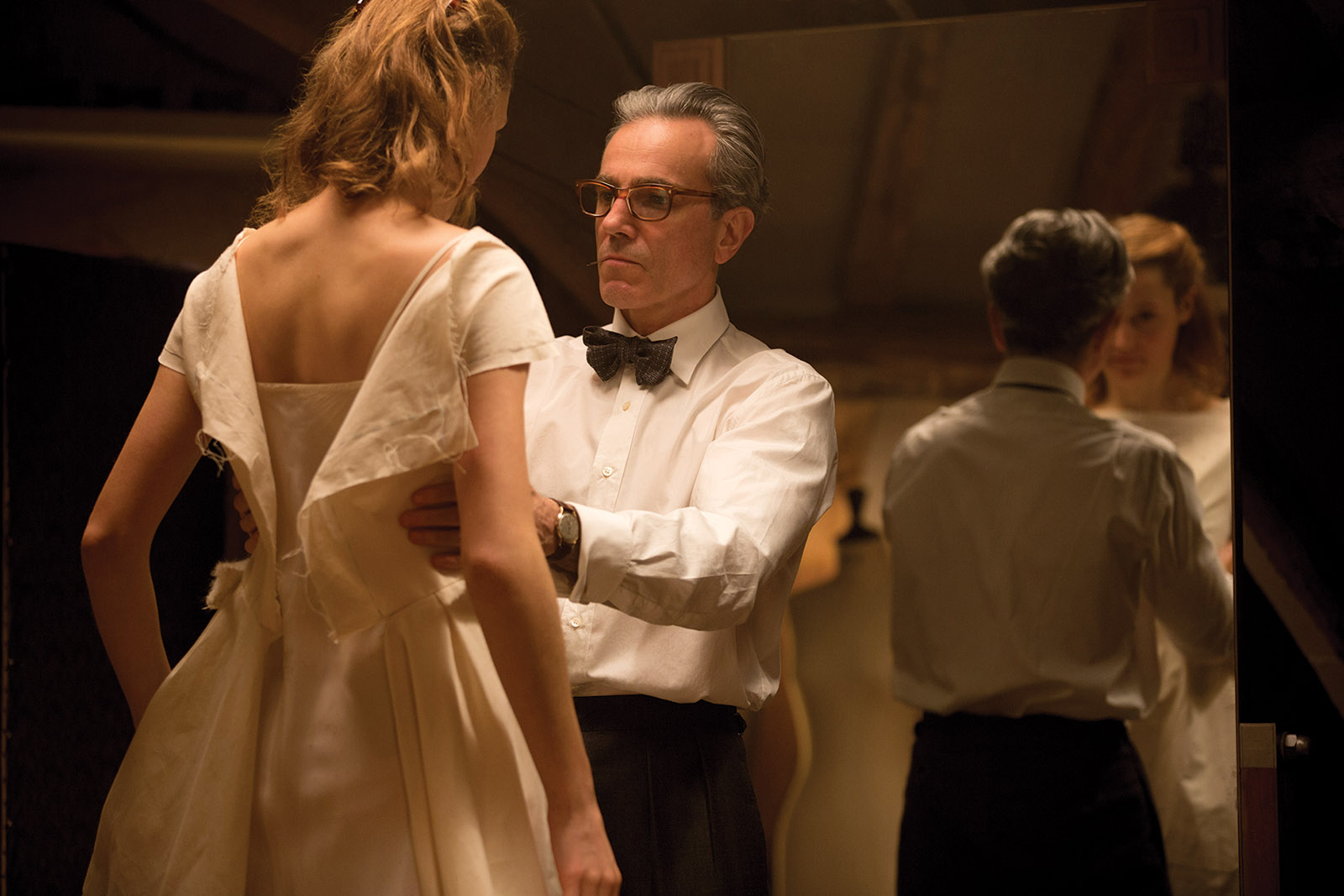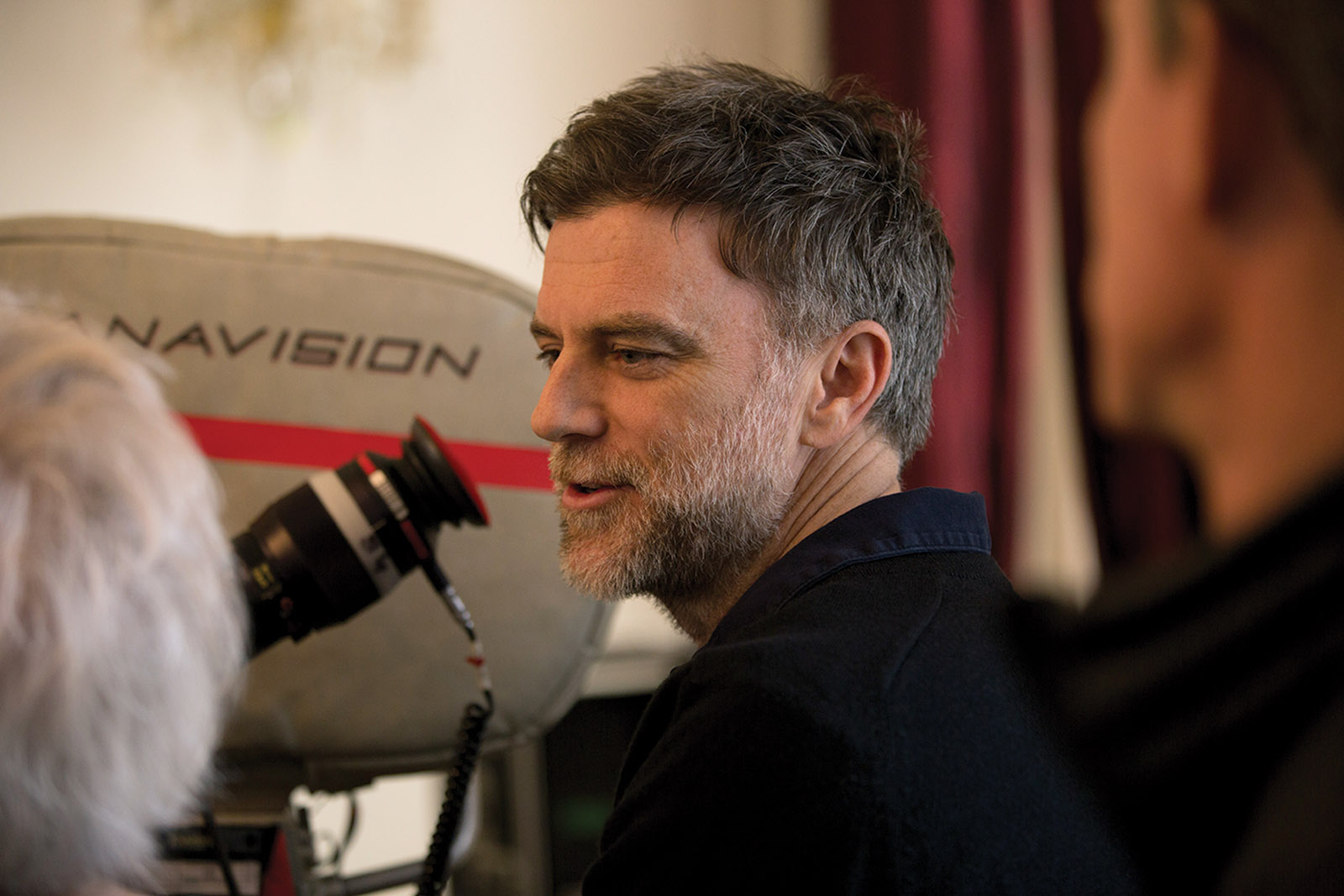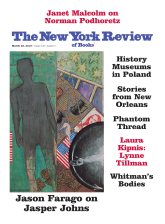“I find it comforting to think that the dead are watching over the living,” Daniel Day-Lewis happily confides to a new acquaintance several scenes into the writer-director Paul Thomas Anderson’s Phantom Thread. It’s an odd thing to say to a young woman whom he seemingly plans to seduce, particularly since it refers to his mother.
Phantom Thread, which stars the always remarkable Day-Lewis as Reynolds Woodcock, a domineering master couturier in mid-1950s London, has been characterized by many reviewers as a love story. It is that, being concerned largely with the complicated relationship between Woodcock and a young woman who serves him as a mannequin, studio assistant, and sometime accomplice. But it is also a faux Hollywood melodrama, a gothic romance, a dark comedy, a baroque chamber piece, a study in artistic self-absorption, a discreetly kinky case history, an anti-authoritarian fable, and (as Anderson himself has suggested) a fairy tale.
For a movie about fashion, Phantom Thread is triumphantly unfashionable. In one comic bit of business, Reynolds rants about the use of the term “chic,” spitting out “that filthy little word” as though it were an expletive or an olive pit. At once posh and spectral, the film luxuriates in fustiness. Reynolds may be a prima donna, but he is still the servant of an established order, producing the emperor’s old clothes. The House of Woodcock’s wealthy and aristocratic clients are not dressed so much as they are gloriously shrouded or upholstered by Reynolds in capes and bodices worthy of Walt Disney’s Snow White. I was less impressed with his designs than convinced of his particular genius and that of Anderson, whose robust, enveloping visual style is predicated on unusually close close-ups, subtly skewed compositions, suavely disjunctive editing, fastidious production design, and judicious camera movement.
The author of eight disparate and venturesome features, arguably the preeminent Hollywood filmmaker of his generation, Anderson is an ambitious director with a taste for ambitious characters: the self-made tycoons and self-appointed prophets of There Will Be Blood (2007), the cult leaders and salesmen in The Master (2012) and Magnolia (1999), the would-be movie stars of Boogie Nights (1997). Not the least of his aspirations would seem to be reviving the crowd-pleasing style of Eisenhower-era Hollywood cinema on his own idiosyncratic terms. Punch-Drunk Love (2002), a highbrow vehicle for the lowbrow comedian Adam Sandler, presents its drab San Fernando Valley locations with the visual panache of a 1950s wide-screen musical. Inherent Vice (2014), a surprisingly faithful adaptation of Thomas Pynchon’s convoluted private eye novel, is not so much a neo-noir as the ironic equivalent of an old-fashioned prestige picture proudly presenting a classy best seller. In its resemblance to the Hollywood melodramas of the 1950s, The Master could easily have been called Magnificent Obsession or Bigger Than Life.
Those titles would also have suited Phantom Thread, which is set during more or less the same period as The Master. Everything is drenched in the cascading piano notes of Jonny Greenwood’s lush, romantic score. The production of Woodcock finery is examined in almost microscopic detail. With its lustrous textures and rich, saturated colors popping discreetly from white walls, Phantom Thread suggests the florid Michael Powell movies of the late 1940s and early 1950s that proclaimed the end of wartime rationing. Austerity is over; tasteful excess is permissible for those who can afford it.
Unlike many American directors, Anderson does not seem fascinated with genres. Nor does he choose to make topical films. (Most of his features have been period pieces.) Rather, his character-driven, densely plotted yet elusive movies appear to address his most formidable forebears—Martin Scorsese and Robert Altman to start with, later Orson Welles and Stanley Kubrick, and, in Phantom Thread, Alfred Hitchcock. Anderson might be explained in terms of Harold Bloom’s ideas regarding the “anxiety of influence,” as a “strong poet” staking his claim to historical significance by “misreading” or challenging his strong precursors. This inclination to go up against the big guys is reinforced by the difficult father–son relationships found in many of his films, most of which are ambiguous moral fables of abusive power and personal realization.
Anderson grew up in a show business family. His father, Ernie Anderson, was a disc jockey and TV personality who, among other things, was the hipster host of a Cleveland horror movie show, Shock Theater, under the name Ghoulardi. Paul made video movies as a teenager and briefly attended film school, supposedly dropping out of NYU after a few days. His first feature, Hard Eight (1996), a crime film reminiscent of Scorsese, remains his most conventional movie—an exercise in gangster existentialism in which a dapper, aging Reno cardsharp takes a dim-bulb drifter under his wing.
Advertisement
Anderson addressed Scorsese more directly with his panoramic porn industry portrait Boogie Nights, a two-and-a-half-hour movie with a large cast—including the louche presence of Burt Reynolds, the reigning male star of the late 1970s. It “misread” Scorsese’s mob chronicle and cautionary success story Goodfellas, the most evident influence on its period style and hectic tone, as a sort of underdeveloped metacommentary on the filmmaking process—and added a sense of film history. Whereas Scorsese’s enterprising criminals are essentially no more than themselves, Anderson treats the rise and fall of an adult entertainment star as an allegory of Hollywood cinema and the inevitable advent of video technology.
Magnolia, completed before Anderson turned thirty, is based on another creative misreading. Anderson took Robert Altman’s ensemble film Short Cuts, a portrait of contemporary Los Angeles composed of multiple intersecting stories, for an apocalyptic work. Where Altman was judgmental of his characters, Anderson subjected his to something like the Last Judgment, complicating their respective destinies with a time-bending parallel montage (a nod to D.W. Griffith’s Intolerance) and ending his Los Angeles saga with a full-scale Old Testament plague.
Anderson’s mature films, There Will Be Blood and The Master, have intimations of Welles in their outsized protagonists as well as of Kubrick in the director’s own detached precision. An evocation of frontier capitalism set at the dawn of the twentieth century, There Will Be Blood drew on the first few chapters of Upton Sinclair’s 1920s best seller Oil! to recount the tale of a ferociously successful wildcat oil driller (Day-Lewis, who won an Oscar for his performance). No less than the archetypal movie tycoon Charles Foster Kane, Day-Lewis’s ruthless loner, Daniel Plainview, deserves to have his name followed by the epithet “American.” The same is true of Lancaster Dodd in The Master, another charismatic, flawed tyrant, in some ways modeled after the inventor of Scientology, L. Ron Hubbard. There Will Be Blood and The Master, together with Phantom Thread, constitute a trilogy of megalomania—a natural subject for a self-aware movie director. In his New York Times review of Phantom Thread, A.O. Scott called the film “extravagantly personal” but not autobiographical. Not directly, perhaps: unlike the autocrats of There Will Be Blood and The Master, Phantom Thread’s tyrant is an artist.
Daniel Plainview and Lancaster Dodd have tortured symbiotic relationships with their male rivals or disciples. Reynolds Woodcock—said to have been inspired in part by the eccentric, high-strung Anglo-American designer Charles James—is romantically involved with his female foil, Alma (Vicky Krieps), a young woman of unspecified foreign origin whom he discovers waiting on tables in a rural inn. Her name is suggestive, not only because it is Spanish for “soul” but also because it belonged to the wife and close collaborator of Alfred Hitchcock, whose first American project, the 1940 gothic romance Rebecca, Anderson has cited, along with the supremely fetishistic Vertigo, as a point of reference for this film. Phantom Thread is framed as Alma’s story, told by the fireside to a sympathetic doctor who, as we will learn much later, is treating Reynolds—although, in keeping with Anderson’s irregular sense of structure, it includes several scenes, mainly flashbacks, that Alma could not have observed or necessarily even known about.
Speaking to the camera, with her listener offscreen, Alma ecstatically expresses her deep love for Reynolds, the man who has made her “dreams come true,” and also, she proudly declares, “the most demanding” of men. His perfectionism is illustrated with a montage of his morning routine—his fastidious toilette as a small army of seamstresses ascend the narrow stairs of his Fitzrovia townhouse to be greeted by the imperious Cyril (Lesley Manville), his sister and business manager, whom he calls “my old so-and-so” (as in “sew and sew”). The orchestrated romantic music washing over this daily ritual seems based on variations of the shmaltzy ballad “My Foolish Heart.”
As the persnickety Reynolds takes his breakfast, which he eats while concentrating head-down over a drawing, his current inamorata presses him to try one of the special sticky buns she has ordered. Reynolds’s care and feeding is an important theme in Phantom Thread. Pushing the pastry on him is a grave faux pas, even worse for being committed under Cyril’s vigilant gaze. Manville, who has often played softer roles in the films of Mike Leigh, is here haughtily perched in all her scenes, as watchful as a red-eyed vireo. Improbably but not inappropriately given a royal-sounding masculine name, she functions as Reynolds’s praetorian guard. The young woman will be given a dress and expelled from the House of Woodcock.
Reynolds departs for his country home, leaving Cyril to tidy up the sticky bun mess, and discovers the fresh-faced Alma serving breakfast at the local inn. Suddenly, he has an appetite. It is love at first sight, leading to one of the oddest first dates in movie history. After taking Alma to dinner, wiping the lipstick off her face, and bringing her home for a chat, during which he describes his great boyhood achievement of creating the wedding dress for his beloved mother’s second marriage, he propositions her—to serve as a mannequin. The remainder of the night, during which Cyril joins them, is spent fitting Alma for a dress. (One wonders if the child Reynolds did the same for his mother or only imagined that he might.)
Advertisement
Alma is tall, slender, and highly disciplined. (“No one can stand as long as I can,” she informs her unseen interlocutor.) In her, Reynolds believes he has found his ideal. He tells her that she has “no breasts” and explains it’s his job to give them to her. There’s a wonderful shot in which Reynolds sits cross-legged on the floor of his studio, needle in hand, looking up at Alma in a dress he has fashioned, lost in admiration for his creation—or rather creations. At least for its first half, this story of an artist who falls in love with his model is reminiscent of Shaw’s Pygmalion. Thereafter, Phantom Thread might be a postscript to the play as imagined by Hitchcock.
More willing than Reynolds to acknowledge the importance of collaboration, Anderson has staked his success on partnering with his actors. Performance often matters more than narrative logic in his films. (Joaquin Phoenix’s sensational turn as the acolyte in The Master seems largely based on the odd simian crouch he affects for the role.) Day-Lewis, who made uncredited contributions to the Phantom Thread script and maintains that it will be his last film, bares scant resemblance here in voice and demeanor to the demonic oil tycoon of There Will Be Blood except that both characters are obsessed with their work. Reynolds is as distinguished-looking in his swept-back silver hair as Christopher Lee’s Count Dracula, an elegantly lean figure with a scimitar-sharp profile.
Appallingly fussy and generally humorless, apart from his capacity for nasty sarcasm, Reynolds tries to cut Alma down to size. Alma, however, has a peasant stubbornness, proving to be unexpectedly willful and clever in handling Reynolds and his formidable sister. A good deal of Phantom Thread’s subtext derives from the spectacle of Krieps, a thirty-four-year-old actress who has until now appeared almost entirely in German-language films and speaks oddly accented English, going up against one of the world’s most forceful performers.
Reynolds turns out to be acutely sensitive. Perhaps it is a symptom of incipient madness. He is driven nuts by the sound of Alma industriously buttering and ingesting her morning toast, suggesting that it is as much of a distraction as if she had ridden a horse across the room. “If breakfast isn’t right, it’s very hard for him to recover for the rest of the day,” chilly Cyril explains. Versions of this scene will be repeated throughout the movie.
Reynolds’s morbid sensitivity also results in spells during which, undergoing a sort of regression to childhood, he is forced to take to his bed, allowing Alma to nurse him back to health. Her realization that she might be able to induce such spells changes the couple’s balance of power. (“How long do these episodes last?” the curious doctor inquires.) Even apart from this maternal role, Alma is fiercely protective of Reynolds. Physical passion, largely absent from their onscreen relationship, arises most dramatically out of her defense of his art, as when he is commissioned to design a wedding dress for the American vulgarian Barbara Rose (Harriet Sansom Harris). That this pitifully neurotic woman might be inspired by the Woolworth heiress Barbara Hutton is implied both by her name and her groom, modeled after Hutton’s fifth husband, Porfirio Rubirosa, a Dominican playboy who, as the movie makes clear, sold visas to French Jews during World War II. When, at the wedding banquet, Barbara drunkenly plants her face in her plate, Alma feels the sacrilege even before Reynolds does. Anderson has at last given her a class enemy. The expedition upon which Alma and Reynolds embark to retrieve his emerald-colored satin gown from its undeserving, unconscious owner is not only the movie’s comic set piece but also the most joyful expression of their relationship.
Anderson makes movies that may refuse to explain themselves but nevertheless manage to engage the viewer, in part because he tends to cut from confined spaces to open ones as if inviting us to enter them. With its narrative repetitions and cryptic passages, as well as a honeymoon scene in the dazzling whiteness of the Alps and the lengthy Magic Kingdom New Year’s sequence that follows, Phantom Thread has a ballad-like quality. Imagining himself always being watched by the absent mother to whom he is so attached, and who makes a ghostly appearance during one of his “episodes,” Reynolds also believes in an unspecified family curse that he credits Alma with breaking. In the end, Alma, who has figured out how to cast a spell of her own, has other ideas regarding the afterlife. Depending on one’s sense of her relationship with Reynolds, these can be read in several ways. Are the scenes that conclude her conversation with the doctor meant to be taken as optimistic fantasy or complete delusion? Does the movie have a Hollywood happy ending or rather the parody of one?
If Phantom Thread is Anderson’s Hitchcock film—Notorious and Suspicion, two other tales of perilous marriage, have also been mentioned by critics—it is an example of what Bloom calls “the return of the dead,” a maneuver by which “the new poem’s achievement makes it seem to us, not as though the precursor were writing it, but as though the later poet himself had written the precursor’s characteristic work.” The “characteristic work” in this case is Rebecca, in which the timorous, innocent Joan Fontaine is required to rescue Laurence Olivier from the spell cast by his dead wife Rebecca and their malevolent housekeeper Mrs. Danvers, who is Rebecca’s representative. It is as if Anderson had directed Rebecca as a dry run for Phantom Thread’s far more unusual, psychologically fraught, and Oedipal love story, where Reynolds’s dead mother stands in for the Olivier character’s dead wife.
In fact, all the characters in Phantom Thread are more convincingly human in their complexity than those in Rebecca. Day-Lewis’s Reynolds becomes a more complicated and vulnerable Byronic hero than Olivier’s, Cyril replaces the villainous Danvers, and Krieps gives a welcome feistiness to the Fontaine role. Phantom Thread is also a movie in which, unlike in Hitchcock, male authority is shown to be undermined by childish need—Reynolds repeatedly and perhaps permanently cedes dominance to Alma. Are matters then resolved? The very title is a tease. Does it refer to Reynolds’s life, to the ties that bind him to Alma, to Anderson’s body of work? On the one hand, the phantom thread is the theme of authority and dominance that runs through many of Anderson’s films; on the other, it is film itself.
In his metaphoric and self-referential documentary The Man with the Movie Camera, the Soviet filmmaker Dziga Vertov used sewing as one of his metonyms for montage. The close-ups of stitching and basting are the phantom thread holding together Anderson’s film, which, given its temporal shifts and mutable tone, could have easily in lesser hands been a patchwork quilt. This is Anderson’s densest and most invisibly edited movie, but not so invisible that you aren’t invited to admire its virtuosity. Casting, dressing, posing, coaching, cutting, assembling: Phantom Thread is all about making a movie. Could it be that Anderson is speaking through Reynolds when the couturier takes up the thought that “the dead are watching over the living”? In the cinema, it’s just the reverse.





